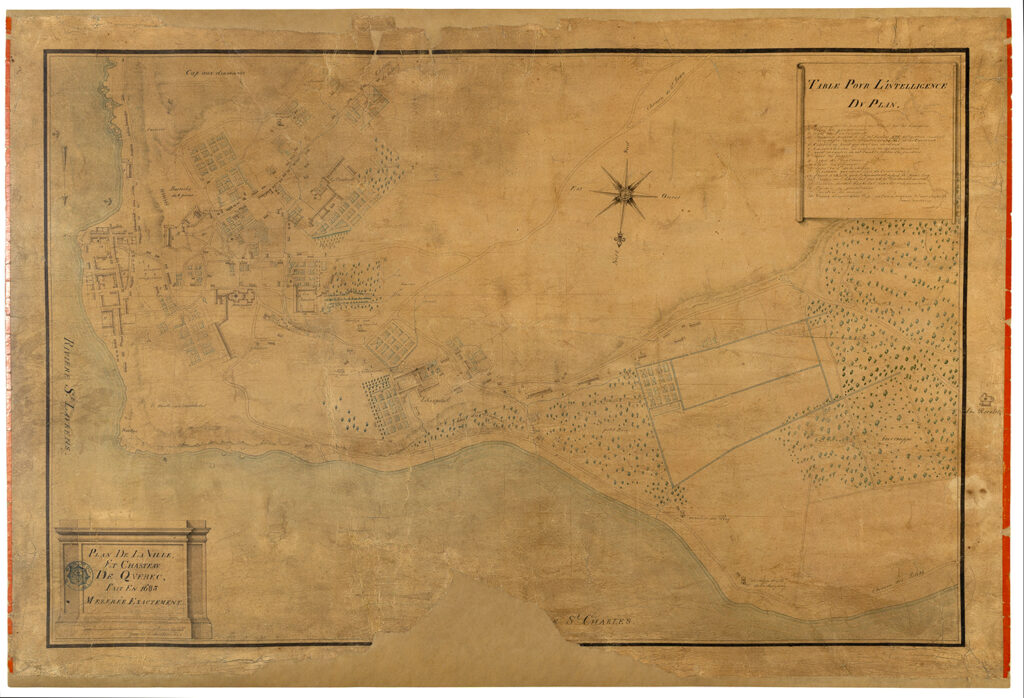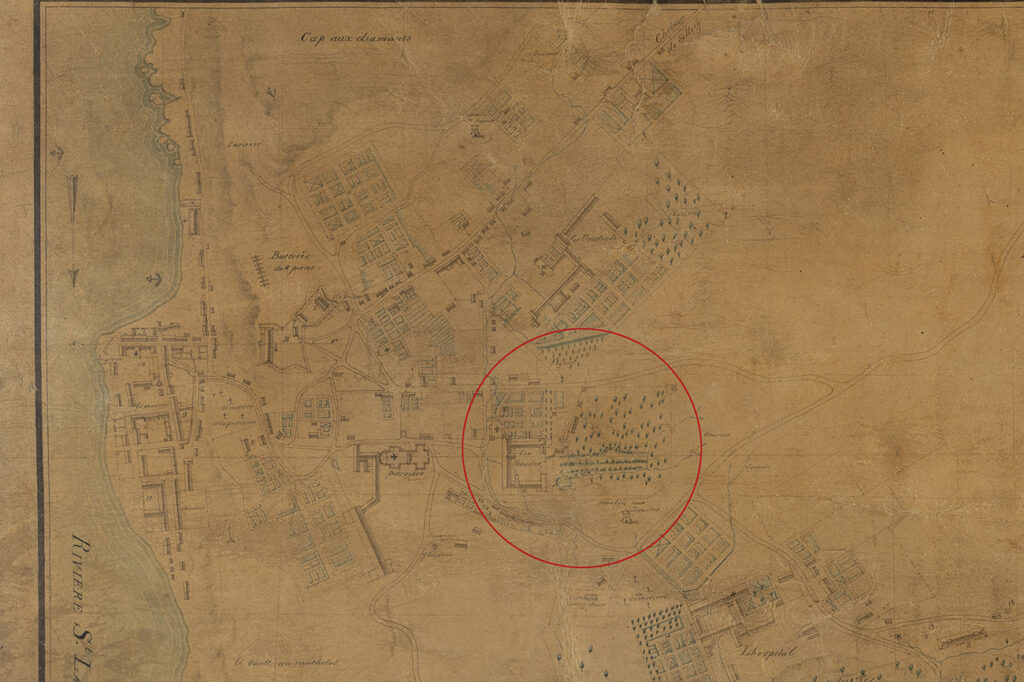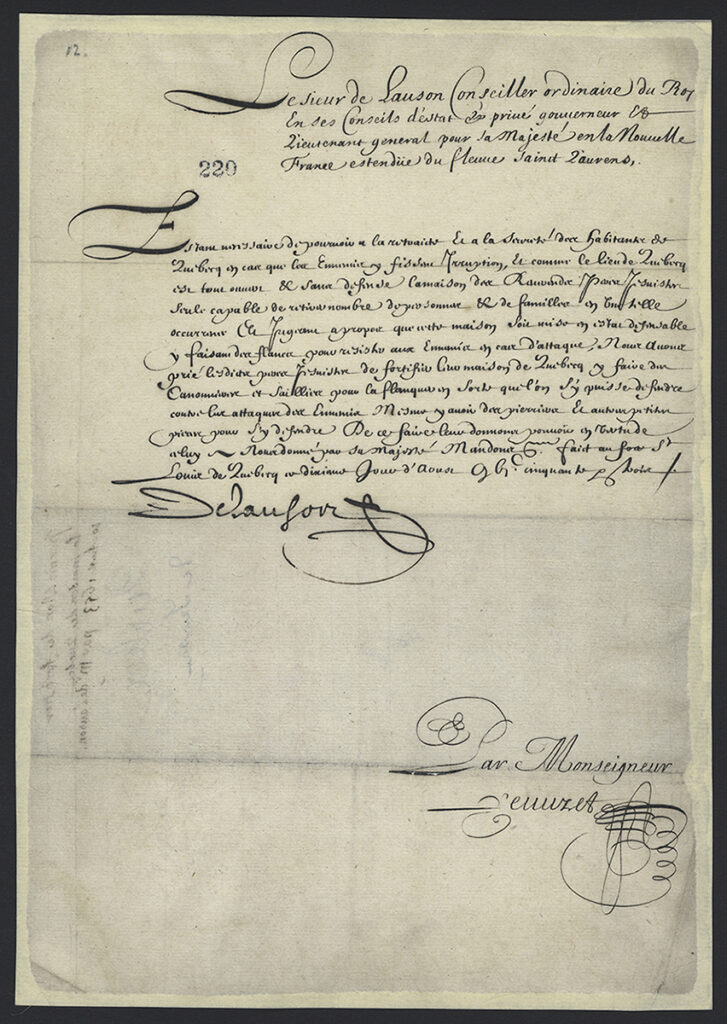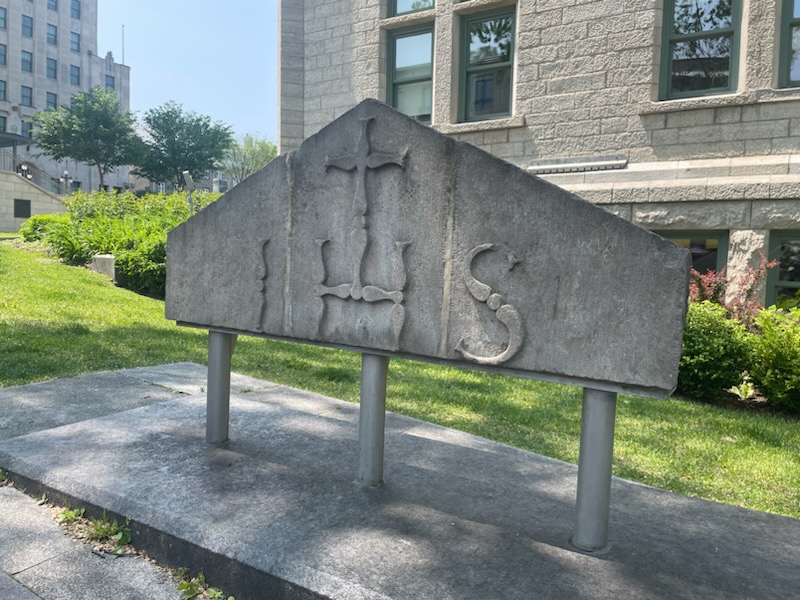Dr. Fannie Dionne and Patricia Prost
15 June 1625. After weeks of sailing across the North Atlantic, the first Jesuits disembarked in Quebec. Fathers Ennemond Massé, Charles Lalemant, and Jean de Brébeuf, accompanied by two brothers, discovered the small town with, among other things, a fort, several houses, and a Recollet convent. That was 400 years ago.
The Archive of the Jesuits in Canada (AJC) contains few traces of this arrival and the early years of Brébeuf and his confreres’ mission. In fact, the records of the Society of Jesus that date from this period, scattered between 1800 and 1842, have only been partially recovered. Among the pieces that allow us to dive back into the period is a map dating back to 1685. The map highlights the presence of the Jesuits and another male religious order: the Recollets.
Recollets and Jesuits 400 years ago
The Jesuits landed in Quebec in 1625, but it was not Fr. Massé’s first transatlantic journey. He had been a missionary in Acadia between 1611 et 1613 before he had to return to France, where he shared the story of his stay with Indigenous peoples. His experience inspired other members of the Society of Jesus and helped set in motion the wheels that would lead to the Jesuit order returning to the French colony.
According to historian Éric Thierry, accounts from the Acadian mission motivated influential Jesuits, such as Fr. Jean de la Bretesche (a relative of the Duke of Ventadour and Cardinal François of La Rochefoucauld) to work behind the scenes to have members of the Society of Jesus sent to Quebec, where Recollet missionaries had been working since 1615.
Although the Recollet had not planned to share their mission with Ignatius of Loyola’s disciplines, they had no choice but to accept their presence once they were faced with a fait accompli. Those in Quebec welcomed the Jesuits to their convent upon their arrival, until the new missionaries could build their first home on the lands of the Notre-Dames-des-Anges seigneury, located on the site of the present-day Cartier-Brébeuf park in the Limoilou neighbourhood. During this period, in collaboration with the Recollets, the Jesuits worked with French Catholics, celebrating mass and feast days, in addition to beginning the first missions in Indigenous communities. As a result, as early as October 1625, Brébeuf departed to spend the winter with the Innu before being sent to the Wendat in 1626 with Fr. Anne de Nouë and the Recollet priest, Joseph de la Roche Daillon.
In 1629, the capture of Quebec by the English forced all religious orders to return to Europe, putting a temporary end to the mission.
The new growth of the Jesuit Mission in Quebec

In 1632, the British returned what was known as “New France” to the French. That same year, the Jesuits were the only religious order that returned to the French colony. Their apostolate then extended across several areas and thousands of kilometers. While many aspects of these missions are not apparent from Villeneuve’s bird’s-eye view of Quebec, this perspective highlights services rendered by the Jesuits to the population in a location close to the colony’s government.
For instance, the Jesuits founded their college in 1635, where they offered the classical course as it was taught in Jesuit colleges in France. The sciences were not neglected as, beginning in 1708, a hydrography course and training courses for pilots and surveyors in the colony were added. The college also housed an important library and an apothecary.
The importance of the Jesuit presence in Quebec is reflected in cartography from that period. Drawn to scale and rich in details, the Plan de la ville et chasteau de Quebec, fait en 1685 mezurée exactement [Map of the city and castle of Quebec made in 1685, exact measurements] enables us to see the location and configuration of the college’s stone buildings that began to replace the first wooden structures in 1648. The Recollets, who returned to the colony in 1670, were present in Villeneuve’s drawing, but at the margins of the map.
This map is the work of engineer and cartographer Robert de Villeneuve. Sent to New France in 1685, he created the map for military purposes, with a view to fortifying the city. We do not know the provenance of this copy of the Villeneuve map. We do know that it was part of the collection of the Jesuit residence on Dauphine Street in Quebec City. It was exhibited in 2012-2013 at the National Museum of the Fine Arts in Quebec, as part of the exhibition entitled Les Arts en Nouvelle-France [The Arts in New France]. Another, even more detailed copy is held by Archives nationales d’outre-mer [The National Overseas Archives] in France, in the Fortification of the Colonies repository.
Villeneuve’s work shows the three wings of the building arranged around a central courtyard. They house both the college and the Jesuit residence. The map also shows the adjoining church, whose construction began in 1666. We can see large gardens and a small stream that ran through the property, as well as a mill below, near the current Côte de la Fabrique.

The AJC holds another original document that attests to the scale and importance of this architectural complex. In 1653, Governor Jean de Lauson ordered the Jesuits to fortify their building so that residents could take refuge there in the event of an attack:

“And since Quebec City is completely open and defenseless, the house of the Reverend Jesuit Fathers is the only place capable of sheltering a large number of people and families in such an event […], we have asked the said Jesuit Fathers to fortify their house in Quebec, to build gun ports and projections to flank it so that it can be defended against enemy attacks, and even to have stone throwers and other small pieces of artillery to defend it.”
Permission de fortifier la maison de Quebec, 10 août 1653. [Permission to fortify the house in Quebec, 10 August 1653.] AJC, Q-1.220.
Villeneuve’s plan gives us an idea of how large buildings in this period have shifted over time and in different ways. For instance, the facade of the complex inhabitant by the Jesuits overlooked what is now the Rue des Jardins in Old Quebec, opposite what was then the Notre-Dame-de-Recouvrance church, now occupied by the Notre-Dame de Quebec cathedral. The Jesuit college changed significantly as well, since it was demolished at the end of the 1870s after having served, among other things, as a military depot and barracks following the seizure of Jesuit property by the British government after their conquest of New France. This site is now occupied by Quebec’s city hall, where the former pediment of the Jesuit college is still prominently displayed.

References
Galarneau, C. (2015). Collège des Jésuites. Dans l’Encyclopédie canadienne. www.thecanadianencyclopedia.ca/fr/article/college-des-jesuites
Ministère de la Culture et des Communications. Plaque du Collège des jésuites. Répertoire du patrimoine culturel du Quebec. https://www.patrimoine-culturel.gouv.qc.ca/rpcq/detail.do?methode=consulter&id=99399&type=bien
Morisset, G. (2003). Villeneuve, Robert de. Dans Dictionnaire biographique du Canada. https://www.biographi.ca/fr/bio/villeneuve_robert_de_1F.html
Ouellet, J. (19 novembre 2015). L’ancien Collège des jésuites (1825). Vues anciennes de Quebec. https://histoireurbaine.wordpress.com/2015/11/19/lancien-college-des-jesuites-1825/#_ftnref9
Labrecque, P. (2006). Historique. Ville de Quebec. Répertoire du patrimoine bâti. Fiche d’un bâtiment patrimonial. Hôtel de ville de Quebec. https://www.ville.quebec.qc.ca/citoyens/patrimoine/bati/fiche.aspx?fiche=6180
Lumbroso, S. (2023). « Recollets contre jésuites, entretien avec Éric Thierry ». Revue d’histoire de la Nouvelle-France, (3), 54–55.
Palomino, J.-F. (2012). Pratiques cartographiques en Nouvelle-France : la prise en charge de l’État dans la description de son espace colonial à l’orée du xviiie siècle. Lumen, 31, 21-39. https://doi.org/10.7202/1013065ar
Turcotte, G. et al. (avril-mai-juin 2008). La présence jésuite à Quebec du 17e siècle à nos jours. Le Brigand, (494), p. 10-12. Une version de cet article est disponible en ligne : https://www.chapelledesjesuites.ca/un-peu-dhistoire/la-presence-des-jesuites-a-quebec-du-17eme-siecle-a-nos-jours/
Ville de Quebec (s. d.). Histoire du Collège des jésuites. Patrimoine. L’archéologie à Quebec. https://archeologie.ville.quebec.qc.ca/sites/college-des-jesuites/histoire-du-college-des-jesuites/
